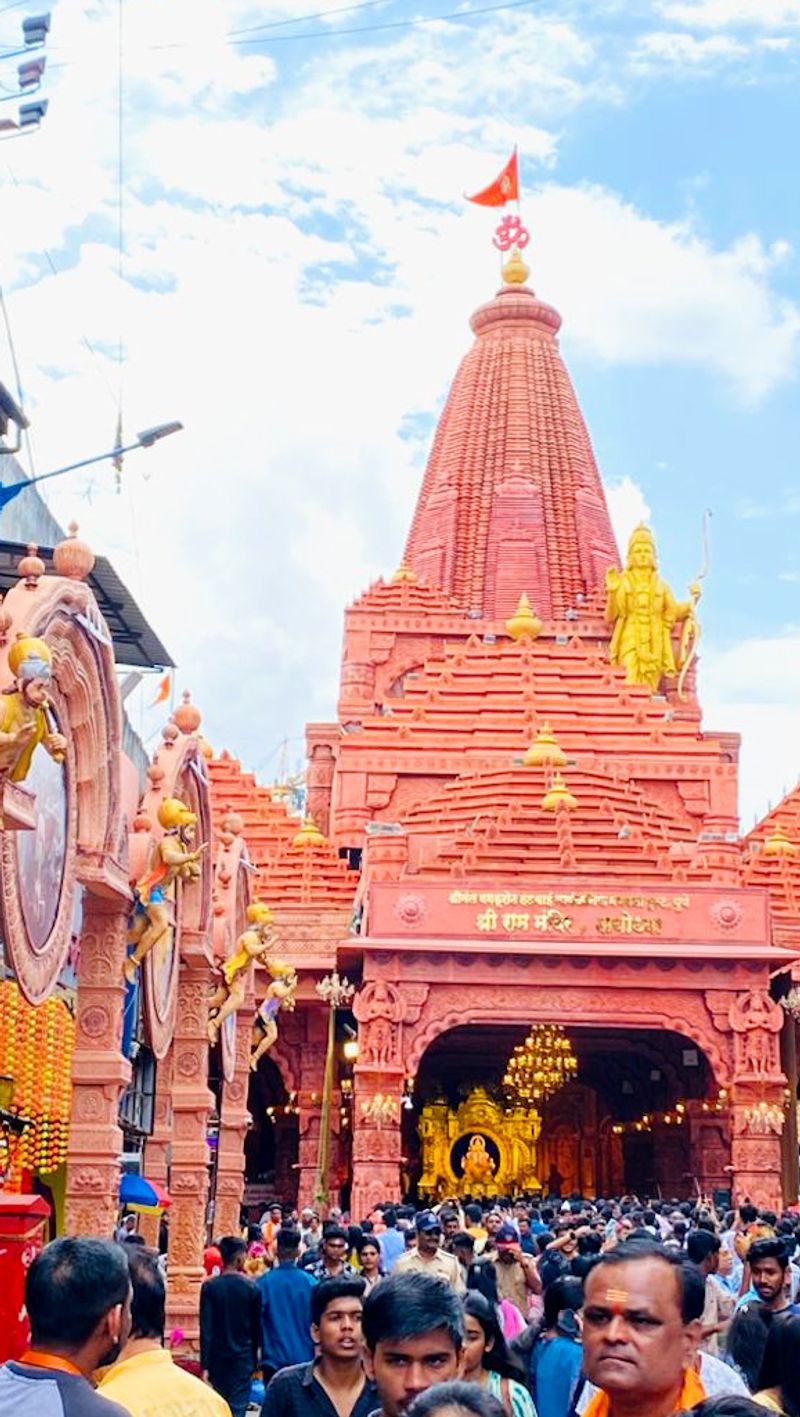synopsis
Discover the vibrant Ganpati festival celebrations in Pune's Dagdusheth Halwai Ganpati Pandal, featuring a replica of the Ram Mandir in Ayodhya. As part of the International Ganesh Festival, let us learn more about the rich history and legacy of the highly-revered temple.
Celebrations continue across Maharashtra as their revered Lord Ganpati is in town to bless the devout with prosperity and well-being. Spectacularly decorated pandals reflect the deep-rooted sentiment between the 'Bappa' and his devotees. As part of the International Ganesh Festival, this writer visited one of Maharashtra's most revered Ganpati pandals -- the Dagdusheth Halwai Ganpati Pandal -- in Pune.
The chants of Ganpati Bappa Morya could be heard much before one arrives at the pandal. Massive installations adorn the sides of the road. The flow of devotees -- hundreds of them -- continues amid the normal day-to-day life of the Punekar. During the Ganpati festival period, a pop-up market has the crowd buzzing. From toys to clothes, kitchen utilities to eating joints, jewellery to even kiosks offering treatment for multiple ailments dot the narrow lane that leads to the Pandal.
Unlike every other pandal, the Lord at Dagdusheth does not get immersed. For the duration of the festival, the highly-revered idol shifts from the silver-adorned Dagdusheth Halwai temple to the pandal, the theme of which changes every year. A smaller idol of the Lord is immersed in the river.

Ram Mandir Theme
In its 121st year, the Dagdusheth Ganpati has been housed within a pandal that resembles a replica of the Ram Mandir. The imposing pillars lit up with chandeliers don't give the impression of a make-shift pandal. In fact, one may actually believe that they are in an actual temple.
According to Mahesh Suryavanshi, treasurer of Shreemant Dagadusheth Halwai Ganpati Trust whom Asianet Newsable spoke to, said: "This year, we have themed the pandal to resemble the Ram Mandir in Ayodhya. The original one will be inaugurated in January (2024). Before that, we wanted to give people a glimpse of it."
"The height of the Pandal is 101 feet. The length is 100 feet and its width is 55 feet in the back and 24 feet in the front. We have attempted to replicate the exact model of the Ram Mandir in Ayodhya using fibre. Inside there are 16 pillars, and on the side, there are 60 pillars that depict instances of Ramayan. The sanctum sanctorum of Ganpati has a backdrop of the relation between Lord Ram and Lord Ganesh as described in the Mudgala Purana. Over two crore people visit Dagdusheth temple during the 10-day Ganesh festival," he said.

Third Avatar of the Ganpati
Suryavanshi further gave details of the revered Ganpati idol. He said, "The Ganpati idol is 5.5 feet tall. The width is 3.5 feet. This is the third idol of Ganpati here. The first idol was brought in 1893. The second idol came at 1896. And then in our 75th year, in 1968, the current idol was built."
"A total of 125 kg gold, donated by devotees, have been turned into different sets oif ornaments. If you see the temple, the entire temple is decked with about 500 kg silver. Whatever has been used, has been from the devotion of people. We have tried to maintain that sentiment by not selling those precious metals," he added.

The Story of Dagdusheth Halwai Temple
According to locals, Kisansheth Gadve, migrated from Karnataka to Pune and established himself as a renowned sweet vendor, adopting the name Halwai. He was passionate about mud wrestling and encouraged his son, Dagadu, to train in the sport. Dagadu, under the guidance of prominent wrestler Jagobadada Vastad, excelled in wrestling and also managed his father's business. By the late 19th century, he became a prominent figure in Pune's trade community and was honoured with the title of 'Nagarsheth' by the British, signifying his leadership in trade and money lending.
The Halwai family resided in a building in Budhwar Peth, now the location of the Dutta Mandir. In 1893, when Bal Gangadhar Tilak advocated for the public celebration of Ganesh Chaturthi, Dagadusheth was among the first to support the cause. He actively participated in the public installation of the initial Ganesh idol, originally made from paper pulp and later replaced with a mud idol.

Following a family tragedy, Laxmibai sought guidance from their spiritual guru, Madhavnath Maharaj. He advised her to establish a Dutta idol and construct a temple, urging her to care for the new Dutta idol and the existing Ganesha as if they were her own children to carry on the family's legacy. After Laxmibai's passing, the annual Ganpati celebrations, initially known as Bahulichya Haudacha Ganpati, were continued by a neighbourhood 'Panch Mandal.'
In 1952, Suvarnayug Tarun Mandal, which comprised young volunteers like Tatyasaheb Godse, Advocate Shankarrao Suryavanshi, Mamasaheb Rasane and KD Rasane, assumed responsibility for organizing the annual Ganpati festival and expanded its reach. A new idol of Ganpati was commissioned in 1968. The idol, designed and built by renowned sculptor Shree Shankar Appa Shilpi from Karnataka, draws lakhs of devotees every year.
)
 subscribe to Asianet News Whatsapp channel by clicking here.
subscribe to Asianet News Whatsapp channel by clicking here.